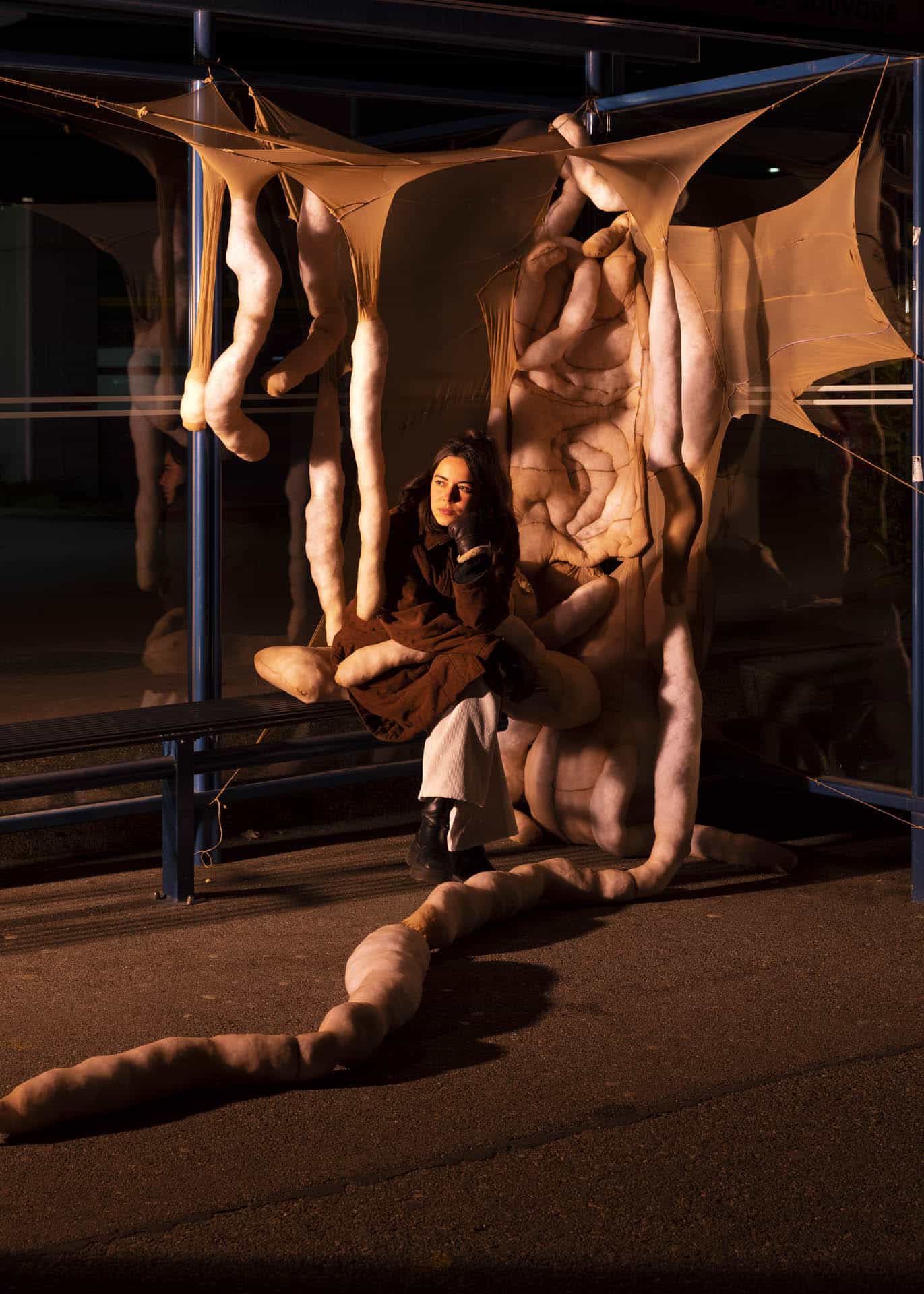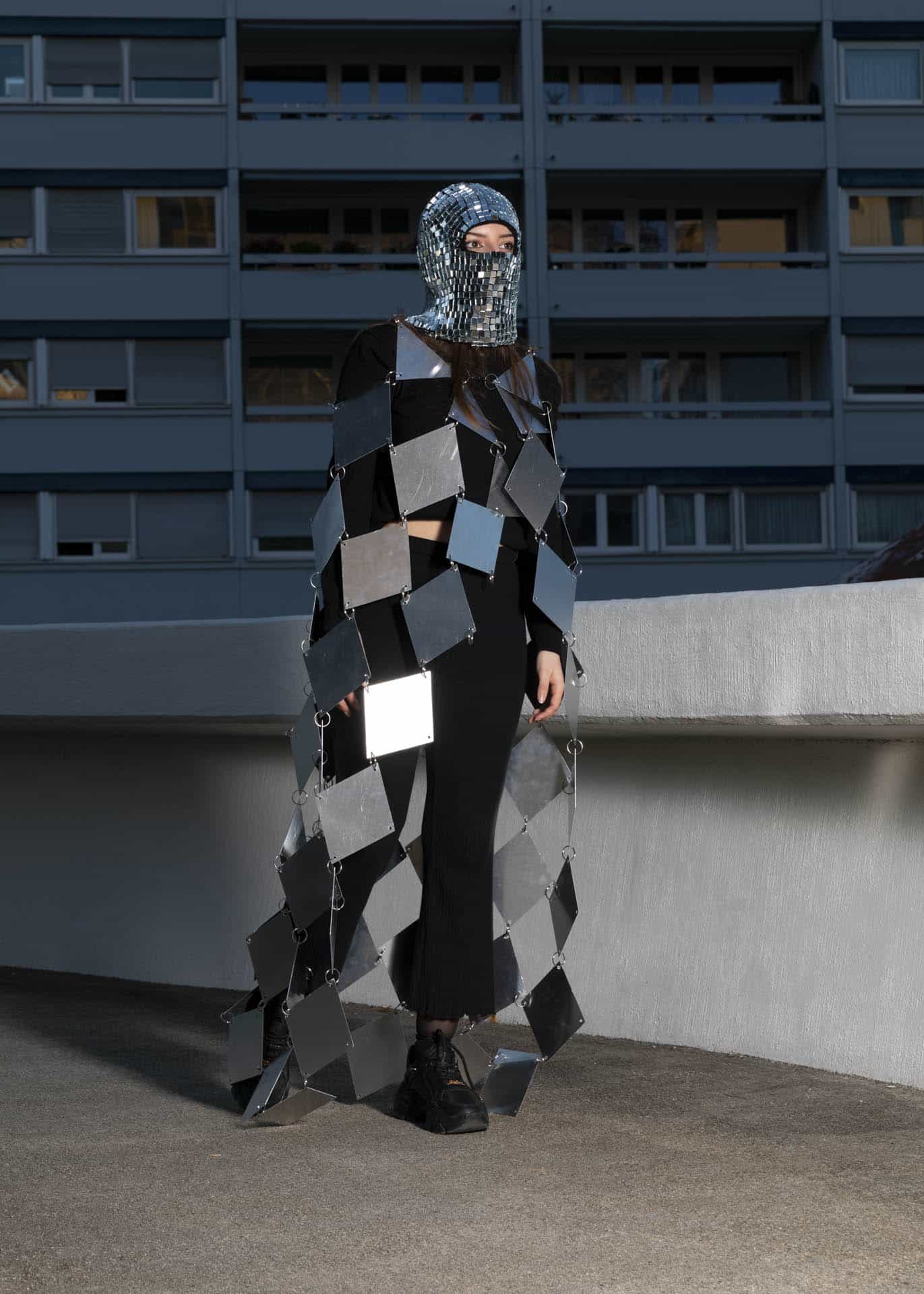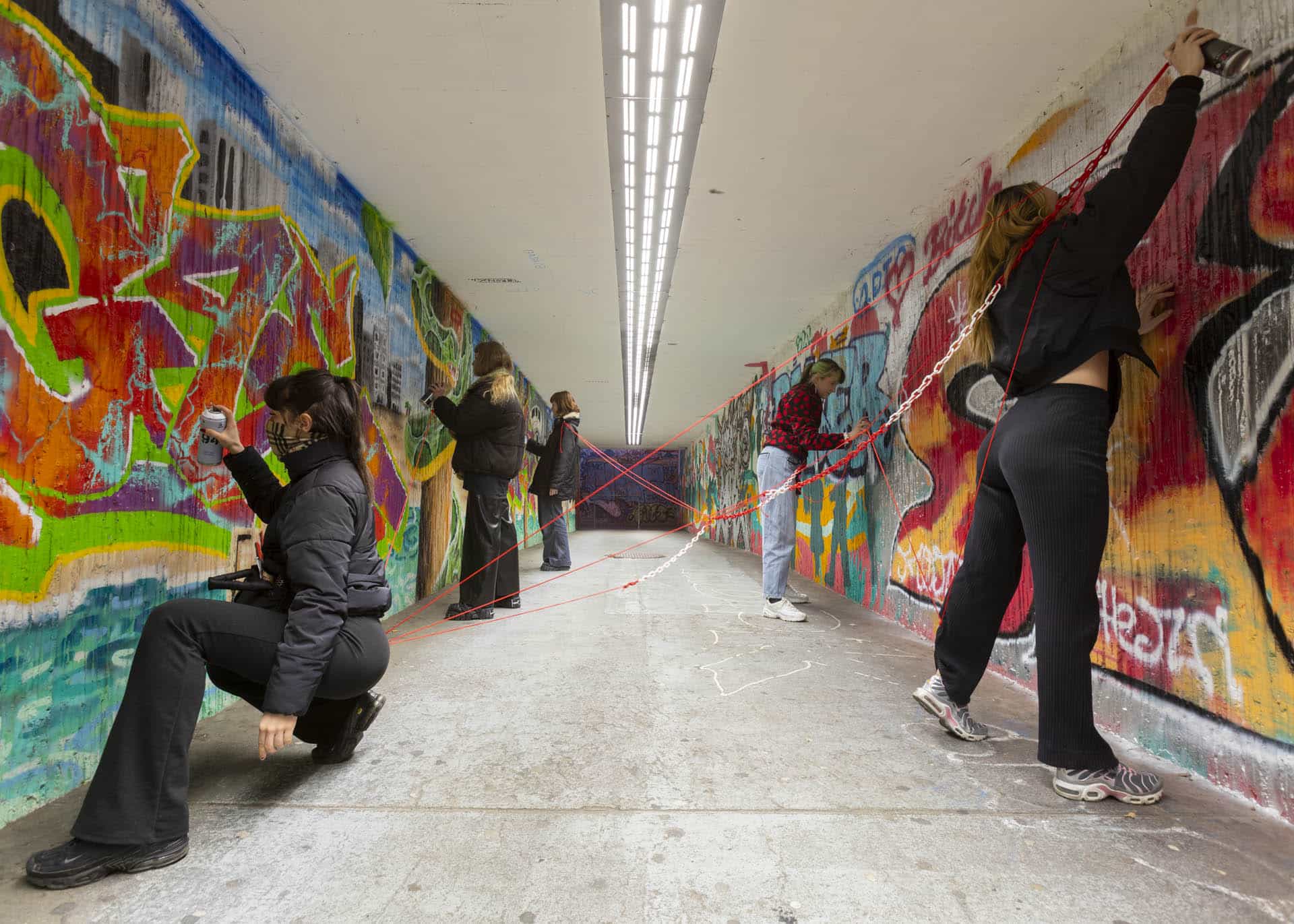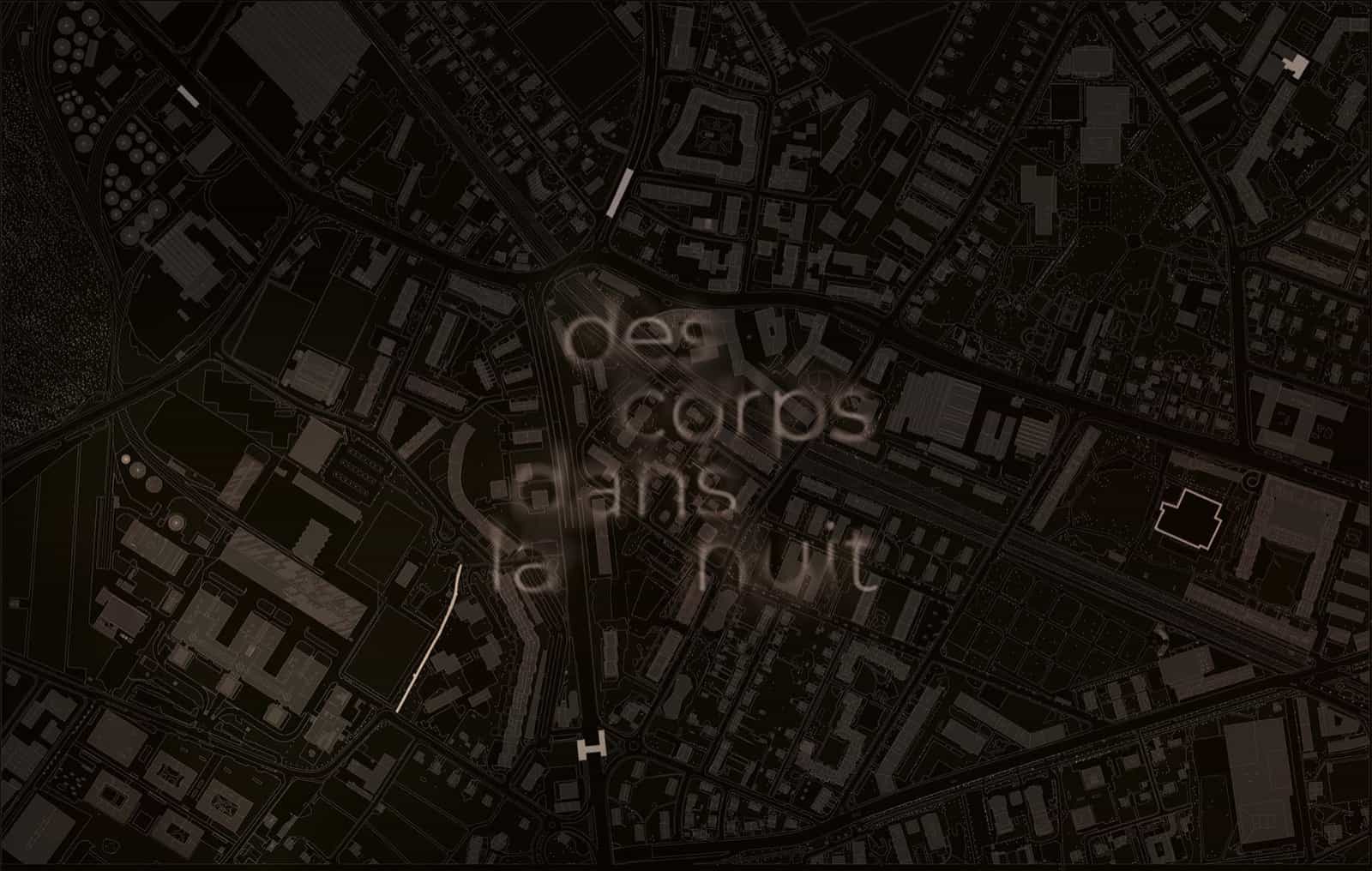Workshop: Gender Dynamics, Normative Transgressions, Solidarities, and Self-Defenses
February 21-25, 2022
Workshop Leaders: Paule Perron, Julien Lafontaine
EPFL & HEAD – Genève, Geneva
Des corps dans la nuit analyzes the materiality of nocturnal spaces—their sensory, programmatic, atmospheric, or separative qualities—and how they participate in the perpetuation of the capitalist and patriarchal domination matrix. Profusely fantasized and represented as time-spaces of dangers, insecurities, and risk-taking at the expense of victims—often female—the nights of Western cities are also claimed and invested as possible territories to subvert, divert, disturb, and transform established patriarchal norms. "Making Space," the title of the manifesto of the feminist architects' collective MATRIX from the 1980s, announces an architectural strategy of resistance through space.
When Iris Marion Young defined the notion of gender in 2002 as "a particular form of social positioning of bodies experienced in interaction with each other within historically and socially determined institutions and processes that have material effects on the environment in which people act and reproduce power relations and privileges among themselves," she underlined the central role of spatial experience in the social construction of gender. The transformation of the environment inhabited by bodies—the architectural action—seems then to open the possibility of subverting normative structures in action through the lived experience of space.
"The night’s western imaginaries were questioned through feminist/queer methodologies"
During the workshop, the night’s western imaginaries were questioned as a space-time of fear, insecurity, and abnormality, producing a gendered polarization of bodies and urban spaces. Through feminist/queer methodologies, exploration of the night as a potential space for renegotiating patterns of domination took place. Delving into spatialized and spatializing subjectivities outlined how night spaces supported these violences and thwarted them. The transformation of bodies’ environments—from clothing to the street—became a vector for possible resistance through space. Delving into protection, spectacularization, disappearance, disturbance as strategies of performative self-defense on the surface of the skin, the workshop explored the lived sensory experience of a gendered body in its constructed environment.
To approach these mechanisms and potentially subvert them, each group of students combined a nocturnal site in the city of Geneva, an architectural project strategy, as well as a film/series/novel scene. These combinations allowed them to situate and position their research. The film/series/novel scene, translated to the Geneva sites, enabled analysis of the intersection of time, space, and social situations, considering the bodies, socializations, and subjectivities that inhabited the night world.
To embody these intersections of human and non-human bodies, temporalities, and social processes, we worked during the week on constructing photographs that stage and situate the performative objects and bodies. Mock-up, collage, and drawing techniques were used to construct the frame, point of view, and elements of each scene, raising questions such as:
For whom do we draw? For what situations? What do we (re)produce by doing so? How do the non-human bodies we design interact with human and social bodies in the context of performative self-defense? Can they performatively turn patriarchal reproduction on its head? Can we redefine the subjects—individuals for whom we work—and the scales at which we interact with them?
These few words from Elsa Dorlin inspired the students' proposals:
“By freeing the bodies from the clothes that hinder the gestures, by deploying the movements, by diverting, deviating the use of familiar objects (umbrella, pin, brooch, coat, heels), by reviving muscles, by exercising a body that lives, occupies the street, moves, balances, the feminist self-defense establishes another relation to the world, another way of being. By learning to defend themselves, the activists create, modify, their own body schema - which then becomes in the doing the core of a political conscientization process.”

The Waiting
Reinterpretation of a scene from the film Ghost Tropic. Bas Devos, 2019
An architectural narration by Nour Keller (EPFL), Valentine Robin (HEAD, Jewelry), Ilona Roux (HEAD, Fashion), Meryem Saffi (EPFL), and Fanny Tauxe (HEAD, Interior Architecture).
She had been walking for hours now, lost in the cold and darkness of the night. Around her, not a car, not a pedestrian—no noise could betray a human presence. Her hands and feet were beginning to burn. She tried to bury her nose in her scarf. Glancing at her watch: 4:20. She didn't feel bad, but not very well either. The city at this hour transformed into a theater of dreams; one quickly felt a victim of their own condition—alone in the unknown. All the shades, all the noises, took on an aspect of danger.
At the end of the road, about 500 meters ahead, a gas station, like a lighthouse in the night, pierced the black veil of darkness with its large green neon lights. The price of diesel, 2.10 CHF a liter, made her grimace. A man behind the counter repetitively counted the coins in his cash register. As she squinted, she thought she saw greyish cylindrical shapes beyond the building—too big to be real. The factory, lost in the concrete jungle, looked like a mirage. There was an aura of mystery about the place. She remembered her childhood fascination for similar places—the feeling of magic, of excess she felt at the foot of these giants. She couldn't help but imagine the many dark experiences hidden between these walls, in the bowels of these iron monsters. Beyond the barbed wire, she saw surveillance cameras, all pointed at the silos.
Drawn by these places, her movements became little by little automatic. She checked her wallet lit up by a yellowish streetlamp; still nothing, not enough to buy a coffee to last the night. Her eyes started to become heavy, and her body, full of shivers, was getting numb little by little. It was at this precise moment, now 10 meters away from the station, that she distinguished an element she had previously omitted. It was a bus shelter— at first sight normal, cold, standing straight on its supports. As she approached it, she saw an indescribable shape mixing with the blue of the metal.
She blinked once, twice, as if to check that she wasn't dreaming, but nothing; the shape was still there, swallowing up half the shelter. And now it seemed to breathe in a peaceful way, perhaps due to the rising wind. This monstrous form—like a heap of flesh, hollows, bits, arms, bumps, fat—was holding out its arms in a welcoming way. In the middle of this dripping mass, this emaciated body, a deformed face smiled at her. The fear that had initially petrified her transformed little by little into warmth.
The initially repulsive creature took the form of a welcoming friend, inviting her to take shelter and forget the austerity of the sleeping city for a few hours. Lulled by the gentle movements of the monster's arms wrapped around her body, she drifted off into a peaceful sleep.

The Crossing
Reinterpretation of a scene from the film Titane. Julia Ducourneau, 2021
An architectural narration by Léa Porretta (HEAD, Cinema), Lou Tissot Daguette (HEAD, Interior Architecture), Alice Proietti (EPFL), and Léo Taillefer (EPFL).
The sun is setting. The streetlights are lighting up.
The shouts of young soccer players are breaking the silence.
The Crossing.
This path between darkness and light.
There are those who walk, and those who stay.
Dark place for the groups, lighted place for the passers-by.
In the open and in the shelter, both are used.
She arrives.
Luminous but hidden.
Wrapped in her cocoon, armed, strong, but reassuring.
She protects herself.
Protects us.
Nothing can wait for her, we are there.
We appear at her side, between darkness and light.
We are omnipresent, unconscious.
In the chiaroscuro, we appear.
We exercise our power.
Armor of war, between iron and mesh.
Nothing crosses her, but she, crosses.
We are multiple and at the same time singular.
The cocoon transits, the cocoon drags and invites itself.
The further the path goes, the more the darkness swallows us, embraces us.
We take place.
The barrier slams.
We inhabit the place, we create ourselves, we deform ourselves.
We disappear.
We are only one.

Indiscrete Subversion
Reinterpretation of a scene from the TV show Buffy the Vampire Slayer. Episode: “Hush”, S4E10, Joss Whedon, 1999
An architectural narration by Salome Djeranian (HEAD, Cinema), Aurora Lajci (HEAD, Interior Architecture), Théotime Serre (HEAD, Media Design), and Waldemar Fierro Rubio (EPFL)
To this day, we still don't know if she's a myth or if she really exists. Some residents say they have seen her crossing the footbridge with a cane, others pulling a shopping cart.
"I once helped her pick up her books."
Student or centenarian? At nightfall, her mirrored hood and visibility cape dazzle all the facades of the housing units overlooking the inner courtyard.
"All we know is that she has superpowers."
The body in movement which strolls along this ramp cannot see who is looking at her.
"Usually, the fountain turns off at 8:00 p.m., but that night it was as if its roar had been replaced by the sound of clashing metal.”
It is, however, the central axis, the convergent point of crossings and meetings. From now on, this place seems to maintain a mystery. This repeated performance gives the feeling of not being able to observe as one pleases.
"The other time I was smoking my cigarette at the window, and I thought someone was calling my headlights from the railing."

The Breakaway
An architectural narration by Mélissa Steenman, Louise Chappuis & Noa Sbaï
Avenue de l’Ain, 11pm
It is dark. I don't want to go by the road. I'll take the tunnel; it's more convenient. I go down the stairs. I pass by the barrier. I have the music on loud. I sing the lyrics to my favorite sound: "How long did you think we were going to tell each other our lives? When I get there, you know what's gonna happen. If I paid, it's not to look at you." Too much Koba the D. A woman arrives in front. I can see her face. She looks down, then looks away. I don't think she noticed me, so I stare at her. The light is so bright that I can see her outfit, which is rather cute. The red neon lights draw my attention to her skin. Stylish these neon lights, by the way, maybe I could shoot my next clip there. I see the girl speeding up; she is surely in a hurry. I can smell her perfume as we get closer. I often take this tunnel. Sometimes we sit down with the guys and have a few beers and smoke some smokes. I took a snap of the tag "Geneva is the jungle." The lion is too stylish, but I prefer the monkey; it is better. I get out of the tunnel. It's ok, it was short. Just enough time to listen to some music. I continue to my home quietly.
Avenue de l’Ain, midnight
Tonight, after school, I went to my friend Anna's house. We watched a movie and talked about things. I stayed there for a while and now I must run to catch the last bus. Once I'm near the stop, I remember; I must cross a tunnel that goes under the road to reach it. I am standing there, in front of my bus stop. Several lines separate us with a few cars racing by without slowing down. Come on, I go through the tunnel; after all, that's where pedestrians like me must go. I go down this ramp. Little by little, I begin to hear voices echoing. Before entering the tunnel, the light is already dazzling me; I hesitate for a moment. I have no idea who I will meet in there. I think about the bus that will be there in a few minutes, and I start to walk. I enter the long corridor. In front of me, before the exit, there is a group of guys not much older than me. They are smoking cigarettes, lulled by the sound of Booba. Some of them are sitting, some standing, some slumped against the walls. I count one, two, three, four, and then, damn it; they've seen me.
Their heads all turn at the same time then, complete silence. I move forward looking around; I don't want to appear vulnerable to them. And then if it is, they are harmless. The wall on my right is full of tags; I look at the blazes in the paint to see if I recognize any of them. All guys. They overlap each other. The wall on my left is a huge mural. I can read "jungle city - Geneva" surrounded by animals. I pass first a chimpanzee with a cap and a gold chain, then a menacing snake with a red halo. A lion, an elephant, and a crocodile. Intriguing choice of animals, only fearsome predators. The Kings of the jungle. I wonder which animal I am in this space when someone interrupts my thoughts; "How're you doing, miss? I remain frozen for a fraction of a second, looking at my interlocutor and not doing anything. I see them all now, I am a few meters away from them. They remind me of the animals on the fresco, laughing among themselves and staring at me with a smile. There is the chimpanzee, the lion, the crocodile, the snake, and the elephant. At this moment, they are the predators, and I am the prey. This is my place in this space that belongs to them, that has always belonged to them. The chimpanzee with the cap insists; "I asked you a question, miss, are you okay?" then follows a string of questions such as "where are you going?" "what's your name?" or "give me your snap!". I want to tell them that I just want to go home, and that I don't have a snap because it's out of fashion. But I don't say anything. I end up being vulnerable, weaving my way between their still bodies as they laugh and call out to me. I end up passing them, hurrying along, and pretending not to hear their insults. My heart is beating fast; I'm finally fine but I'm still freaking out. I tell myself that this is crazy, I always find myself in situations like this, I always end up not saying anything, not confronting them. This time it was enough.
2 days later, Avenue de l’Ain, 23h
It is dark. I don't want to go by road. I'll take the tunnel; it's more convenient. I go down the stairs. I don't hear my music anymore but sound coming from downstairs. I take off my headphones and I hear: "Thank God I ain't got to smack a bitch today. If I see you in the street, your ass is done. I don't need your opinion. Do what I want." That's a bit extreme, isn't it? I arrive next to the barrier. Two women sing the lyrics at full volume with their cigarettes in their mouths. The red neon light shines on me. I can't hide. They look at me and laugh when they see me coming. I look down. Is it my outfit that makes them laugh? I thought my outfit was stylish. It's the same as Koba the D. I see that there are several of them. I've never seen these women. Are they from the neighborhood? We're usually the ones who hang out here. I don't understand. I want to go on my way, but I see ropes that bind them together. I hesitate. If I don't go on, it will look suspicious. They'll think I'm afraid, and since when am I afraid of some chicks, and then it's the shortest way home. But hey, they're a pain in the ass with their ropes; I'll have to duck and be careful with my new tracksuit. There is no way around it. I see them covering the tags I like so much. They are taking over our place. If I had been with my guys, we wouldn't have let them, but now I'm alone. I feel stupid. I think I'm even scared. I've been there. I'm okay. It was long. I'm going home as soon as possible.
Same place, same time
I decided to return to the underground tunnel that connects the two bus stops. But this time, I'm not alone—I'm with my friends. Armed with paint sprays and music, we descend the ramp leading to the corridor, laughing, shouting, already asserting our presence. Once inside, it's magical—the neon lights that once dazzled me now reflect sparkles on our clothes. Estelle and Mel, while dancing to Rico Nasty, light up cigarettes as I take out my sprays. Another friend is slumped against a wall, preparing her next painting. Together, we start to paint, occupying every inch of space. We recreate the horrors we've faced for years—from guys who think they live in a jungle, while we are the ones navigating it daily. Since childhood, we've learned to sneak, navigate dark alleys, change sidewalks, and remain silent to avoid confrontation. At work, at school, with relatives or strangers, we constantly find ourselves kneeling. But this time, they can't do anything; we are together, tied up, claiming our space. I see glitter, resilient individuals who have chosen to stand up for one night to make their mark. I hear the sound of sprays, laughter, and music sung by iconic singers and rappers. Our interconnected ropes create a labyrinth, tangling together without hindering our movements. I see some guys trying to pass through. Some backtrack, choosing to take the road; I don't mind. Others skim the walls to avoid stepping over our ropes, while some get caught up in the chaos before them. We don't size them up; the music is loud, and we talk even louder. I don't know what they're thinking, but I don't care—I'm with my girlfriends, and that's all that matters. I know we won't always be there to confront them, but we did it once, and we can do it again.

Workshop Leaders: Julien Lafontaine Carboni (EPFL), Paule Perron (HEAD – Genève)
Visual identity: Gabriel Vuillemin
Photography: Morgan Carlier, Pool Photo HEAD – Genève
Special thanks to: The participation of Marion Fonjallaz and Morgane Hofstetter throughout the week, as well as that of Karine Duplan, Nayansaku Mufwankolo, Vera Sacchetti, and Dieter Dietz on the final day of the workshop, led to wonderful conversations about the students' productions.
